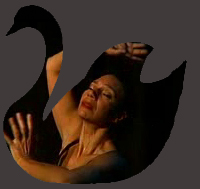|
SWAN: "Coniunctio" (part one) “Why SWAN?” I am asked. When a certain kind of image comes to the artist, she responds. The image impresses upon a receptive intellect the way intuition does: unbidden and on its own accord. Devoid of clever witticisms or conceptualizations, the image beckons attention for different reasons altogether. Archetypal in nature, SWAN offers a portal; embracing the call, the artist brings to light what resonates for this time. Why SWAN? For all of the known and unknown reasons the image itself evokes: qualities and ways of being in the world that desire remembrance. Over the years, I have identified and attended to a central thought in my work: the empathic response through aesthetic experience. “What,” I have asked myself over and again, “is translating across the chasms, across cultures, across time?” I think is has something to do with particular attentiveness to the danced moment, a perception that life is being lived in this unique manner, that dancing is a way of being. And the dance, a form combining those elements that by chance and by mastery engenders a shattering that renders the aesthetic and empathic moment at once. Being becomes transparent. In my teaching, writing, lectures, doctoral research, labwork, and performances, the problem of empathy—an inquiry addressed by 20th century German scholar Edith Stein—has therefore come to particularize my aesthetic purview. Since childhood, I have been fraught with the struggle to articulate, accurately, the palpable experience of bodily-felt empathy. Looking out at the peopled world through these eyes, I have taken note of feeling a kind of sadness—for the people, and my own: mine for not wanting especially to be in the world, and the people, perhaps for being in the world too much. The breadth of my work, crystallized through a meditation on a poetics of the body—the felt inferiority of, relationships to, attitudes about, perceptions regarding, feelings for, and the poetic (empathic) possibilities therein—informs this evening’s dance. Performance is communal in the ancient sense of the term; thus my desire is that you exit this portal with an experience that sheds light on something having to do with you—thoughts that this work is an occasion for— perhaps insights into your own bodily being, and by extension, a re-awakened and particularized recognition of the shared and fragile content of all bodies that make up this world. -Martina SWAN: a poetical inquiry in dance, text, & memoir (Hieros Gamos, ‘divine union’) La practica e filosophia di L. Martina Young Dance Artist / Movement Investigator! I. Dancing as a way of being (ontology/ontologia) ~ Every part of a body is an intelligent organ,— perceptive, poetic in its relational acumen, thinks by feeling, and feels by heart. Night and day, life is noted, breathed in, breathed out,— notitia imprinted and exuded through skin and membrane. Wholly articulate in its sensual brilliance, in its wounded grace, bodies translate corporeal compassion. Always empathic, always intact, a body moves toward balance even in brokenness. Dancing thus raises being to another level. II. Dancing as a way of knowing/not (epistemology/epistemologia) ~ Throughout the lifespan, our bodies offer a portal, a return to the content of ourselves,-- primordial content that links, negotiates, and integrates the actualities and necessities of our human-being-here. Dancing along the divide between life and death, every move embodies such content. III. Dancing as somaesthetic & poetic practice (somàtica estetica e poetica) ~ As a generative and generous act, a dancing body is both the pause and the punctuation that engenders meaning in experiences,— every moment a detail of life being lived, considered-- through felt image, specific and non-specific memory, rhythm, and through the spontaneous relationships made with one’s body/soul, with and without the world. Photograph by Anne Murray
Arte Studio Ginestrelle, Italy 2014 “The green and vermillion glow catches fire, shoots rays, pulsates, subsides, rises again, exploding, all in utter silence” ~ excerpt, “Passages” Giovanni Pascoli “[Like] a ray of light, gesture reflects all that passes in the soul. [For memory], let it be divined, revealed by gesture.” ~ François Delsarte  Los Angeles-based alternative violinist and composer David Strother has been featured in recordings and on stage and film since the 1980s. He has played for numerous local Los Angeles bands, including Lawrence Lebo, Long John Oliva, and The Radio Ranch Straight Shooters. He ranges in style from jazz, blues and swing to avant garde/alternative, but proclaims his passion lies in alternative, both in performance and composition. He attended both Cal State Los Angeles, where he earned a B.A. in classical composition, and Los Angeles City College. Strother has been featured on movie and television soundtracks including for David Lynch in “The Straight Story,” “Philadelphia Experiment II,” “Doug”, and “The Rookie."  L. Martina Young is a native Los Angeleno and a recognized participant in the Los Angeles dance world from the 1970’s through 1990’s. Informed by a politic of community-focused engagement as well as an awareness of the distinction between careerism and living an aesthetic life, Martina joined the Nevada Arts Council’s Artist-in Residence Program, spending months at a time in the rural desert regions and communities of Nevada. In 1987 she accepted an invitation to serve as Director of Dance at the University of Nevada, Reno. Though resigning from her tenured position in 1994, she maintains her studio loft, The Lighthouse/Studio 5 O 2, as a radical hospitality space, in the downtown arts district of Reno—an intimate space for classes, performance, lectures, and other communal affairs.
|
|
This project has been funded, in part, by the Nevada Arts Council, a state agency, and the National Endowment for the Arts, a federal agency.
|












